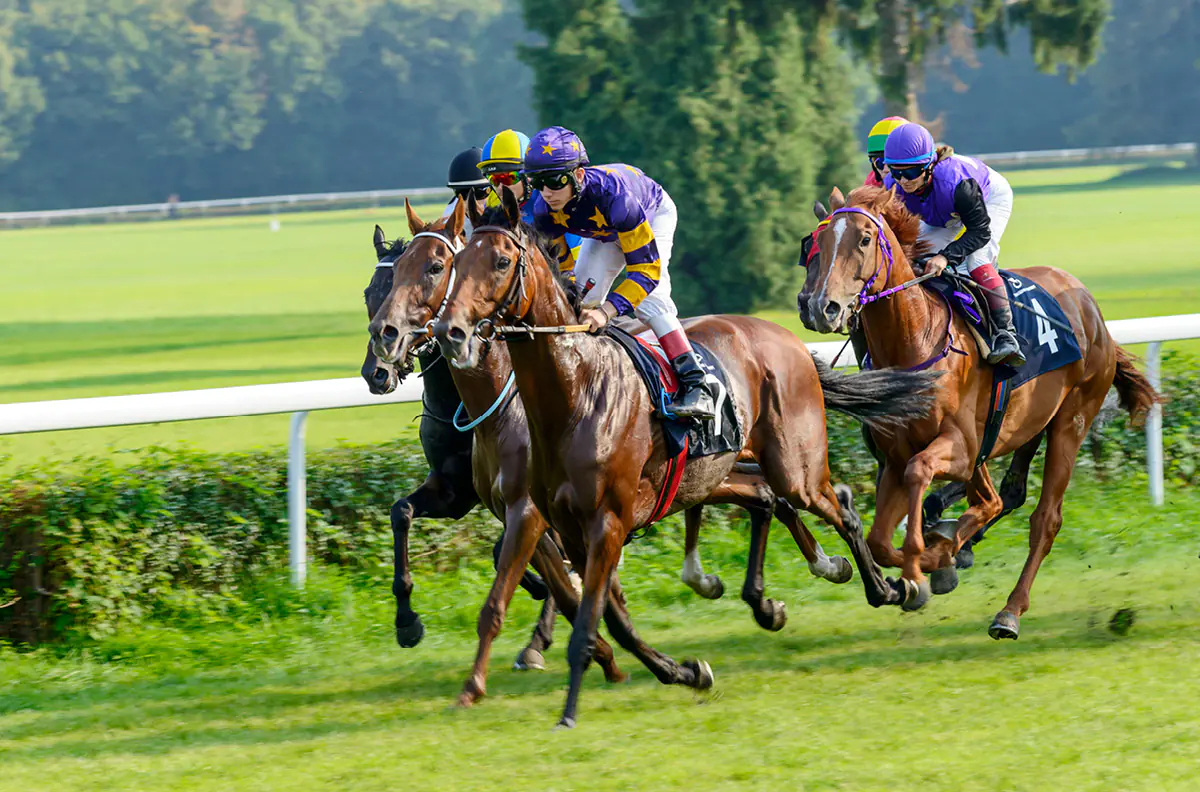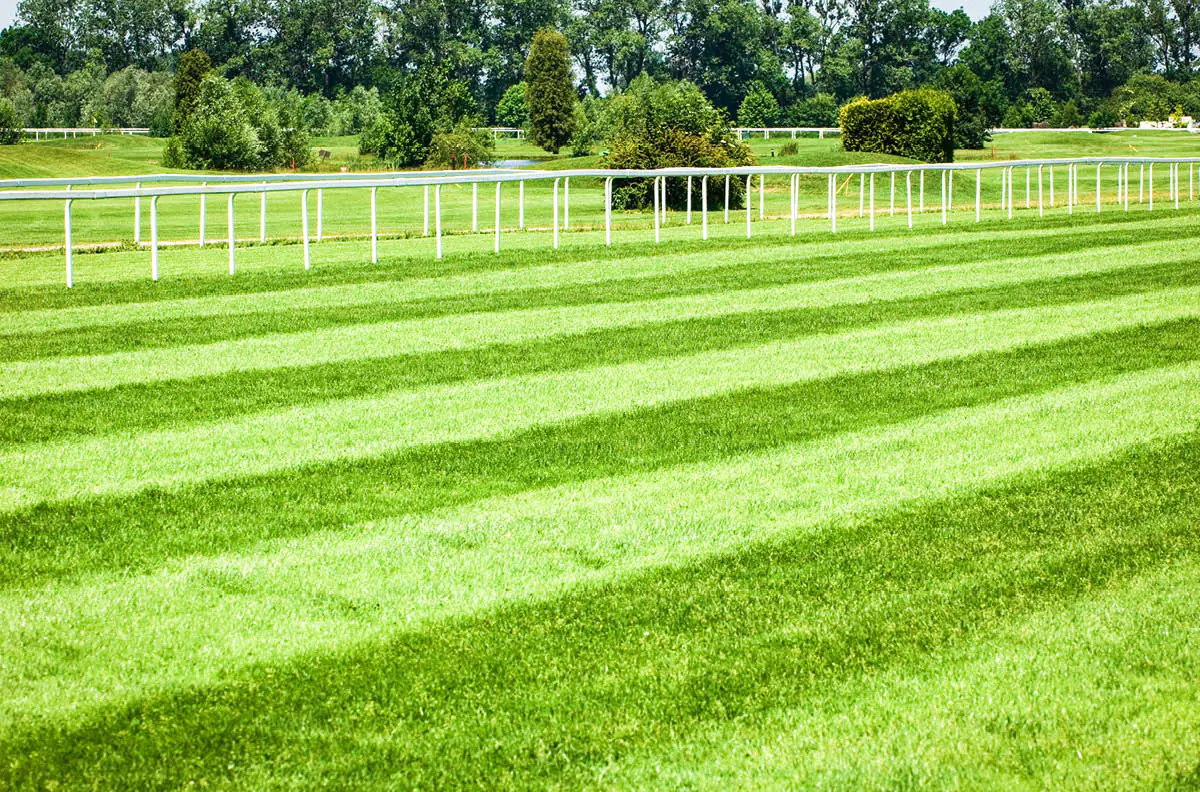Racecourse maintenance
While racecourses may not receive prolonged and intensive wear throughout the entire year, it’s significant that the action of the horses galloping can exert extreme downward force, especially in the landing area of fences.

The specific requirement of a racecourse is to provide a uniform surface from the starting gate to the winning post. Thus, effective turf restoration after a race meeting is important if the required hard-wearing resilient turf is to be maintained.
The aim is to create a resilient, springy turf that grows naturally on heathland and downland, as found around Ascot and Newmarket.
Spring preparation
Harrowing is recommended in early spring to help lift any excess growth before topping with gang mowers. Thorough spiking to open the surface and assist in surface water drainage will also help to encourage deeper root penetration.
The application of spring fertiliser during late March or early April (depending on the weather conditions) also aids in thickening the sward. A slow-release fertiliser such as GSR Tri-Phase should be applied at 350 kg/ha.
In summer, further fertiliser application may be necessary depending on the condition of the turf. However, the application of too much nitrogen should be avoided. Otherwise, soft, lush growth will occur.
Slightly acidic conditions will help with the formation of some fibre while discouraging weeds. The grass should never be allowed to grow too tall but kept mown regularly at the height of 100 mm to encourage it to fill out and improve the general density of the sward.
Racecourse ground renovation
Immediately following a race meeting, the course should be thoroughly spiked to help relieve surface compaction and the localised use of hand forking is advised in obviously compacted spots.
Large divots which have been kicked, together with smaller scars, should be surface dressed with a mixture of topsoil and seed to produce a true level.

Overseeding
In the past, many racecourses have paid insufficient attention to the grasses in the seed mixture and inferior agricultural ley mixtures have been used. However, in recent years, plant breeders have developed new and much-improved varieties of turf-type perennial ryegrasses, which give far superior performance over the old varieties.
These hard-wearing grasses can be relied upon for rapid establishment and will produce a compact and dense sward. They also require less cutting because of their naturally shorter leaf length.
Modern ryegrass varieties are compact, have a high tillering capacity and are well-proven for their wear tolerance and disease resistance. In cases where rapid establishment is required, ryegrasses alone may be used for overseeding. If, however, a wiry, resilient turf is required, our A14 racecourse grass seed mixture can be used.
Most racecourses will eventually exhibit signs of severe wear. When this happens, tufted grasses will begin to invade bare patches. Under such conditions, you should consider a general overseeding programme of the offending areas using a “sod” seeder to tilth and seed in a single operation.
Racecourse grass seed can be sown with success from early March through to mid-October.
Spring/summer racecourse ground renovation
National Hunt courses must be prepared in the spring, while a certain amount of progressive racecourse ground renovation should be done during the flat season in the summer.
To reduce wear, the tracks and fences should be repositioned where possible to allow for natural recovery and the speedier establishment of the renovated areas.
Additionally, a thick layer of hay/straw should be applied two or three days before the meeting to protect take-offs and landings at jumps from severe frost in winter. This helps to prevent deep penetration of frost.
Racecourse ground renovation methods
Soil top dressings
All top dressing must be applied evenly to avoid smothering the existing sward. Materials are best applied while vigorous grass grows, so new foliage may quickly grow through the top dressing. A good quality, screened loam should be used and applied in dry conditions.
Top dressings are most effective when keyed onto the surface. This can be achieved by spiking and forking before and after application or for larger areas, a light harrowing or drag matting.
Aeration and rolling
As for all sports turf, regular spiking is an important operation which is too often overlooked. As stated earlier, spiking helps drainage, relieves compaction and is an important prerequisite to top dressing. Time spent spiking to aid root development is never wasted. The deeper the root penetration, the stronger and more drought resistant the turf will be.
While rolling is an important process in producing a smooth surface, it should always be kept to a minimum. A heavy roller should never be used, and a light Cambridge Ring Roller is best for most racecourses. Remember, the ground should never be rolled in wet weather as this will only seal the surface and impede drainage.
Weed control
A broad-spectrum weed killer will eradicate many more common weeds. Timing is essential, and the summer growing season should be selected when both the grasses and weeds are growing strongly. Great care should be taken to follow the manufacturer’s application instructions and recommended dosage rates.
Land drainage
One of the desirable requirements of any turf is good drainage, which particularly applies to National Hunt meetings held during winter. While installing land drains can be costly, losing a day’s racing can be equally expensive. The cost factor may prohibit introducing a full pipe drainage system, but such work can be carried out progressively, selecting the worst areas first and adding to the system as time and finance allows.
In winter, you should note the locations of particularly wet areas so that suitable drains can be installed in these areas in summer.
Several racecourses have installed complete irrigation systems, as moisture levels affect the turf’s growth and strength. Too much irrigation in the summer months can produce a lush, soft top growth which should be avoided. A close watch on the weather is needed to prevent over-watering. Otherwise, the going will be too soft, and the track will be at risk of excessive damage.
Contact our Germinal Amenity experts to discuss your racecourse maintenance needs.


